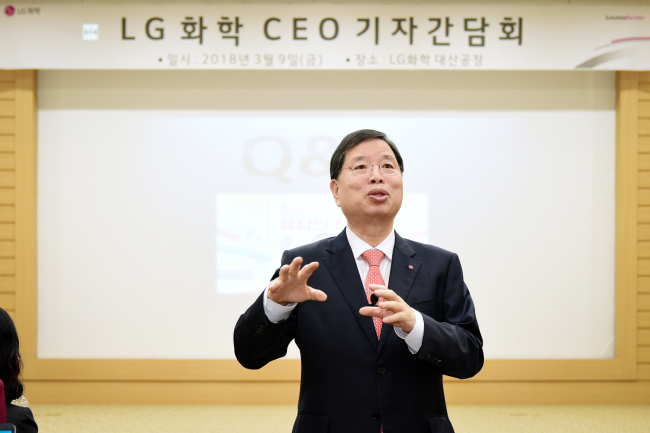SEOSAN, South Chungcheong Province -- LG Chem’s revenue will grow 40 percent in the next two years, driven by rising demand on batteries, particularly batteries for electric vehicles and energy storage systems, the company‘s chief executive said Friday.
At a meeting with reporters Friday at LG Chem’s Daesan complex in Seosan, South Chungcheong Province, LG Chem CEO Park Jin-soo said that batteries will account for “about half” of the 10 trillion won ($9.3 billion) in revenue growth for the company over the next two years.
The company saw 25.6 trillion of revenue last year. It expects to reach 36.4 trillion won by 2020 -- more than 40 percent growth from 2017 -- a challenging figure considering average revenue growth by other major companies rated less than 1 percent after 2010.
LG Chem is the only chemical company manufacturing battery cells in the world.

LG Chem CEO Park Jin-soo speaks to reporters at the company‘s Daesan complex in South Chungcheong Province. (LG Chem)
“A significant portion of that will come from car batteries. It may seem like a stretch, but we have already secured large-scale contracts, so we are confident in the numbers,” Park said, adding that sales growth in bio, information technology and raw materials are also expected.
As of last year, LG Chem has secured supply deals worth 42 trillion won with some 30 global car manufacturers. And the number of its clients has been growing in the US and Europe, as well as China. In the latest, the Korean company announced its partnership with Mahindra & Mahindra, an Indian conglomerate and the owner of South Korean carmaker SsangYong Motor, to develop rechargeable batteries last month.
“It’s hard to say what‘s going to happen in China, but in long term view, there will be an opportunity (for business) when (the Chinese government stops providing) subsidies.”
Park also cited LG Chem’s strength in creating free-form batteries, which can be adapted into various shapes for wider applications. Noting the rising costs of metal required to create batteries, Park said that the company is “making plans” to adjust to the prices of lithium, nickel and cobalt, including “co-work or if necessary, joint ventures.”
To create momentum for the company’s ambitious revenue goals, LG Chem announced investments for this year that were a significant upgrade from 2017. This year, the company will invest 3.8 trillion won in facilities, 1.1 trillion won in research and development and 140 billion won in facility safety, and hire 1,500 people.
“When we talk about our portfolio, we are going to move away from products that can be created easily from ethylene, or large-scale production (to maintain competitiveness over other companies). That’s why we are investing heavily in research and development to about 4 percent of revenue, which puts us at about the levels of global companies like BASF and Dow,” Park said.
The results of such aggressive investment were beginning to appear on-site at the Daesan complex, where LG Chem is building a 400 billion-won plant to produce elastomer, a synthetic material that combines the characteristics of rubber and plastic. Thanks to its high resiliency and shock absorption, elastomer is used widely for car bumpers, shoe soles and electric cables.
Once the plant is complete, the Daesan complex’s annual production capacity for elastomer will increase from 90,000 metric tons to 290,000 tons, making LG Chem the third-largest producer of elastomer in the world after Dow Chemical and Exxon Mobil.
The Daesan complex has also invested 287 billion won to expand its naphtha cracking center facility by 230,000 tons. The NCC is responsible for producing ethylene and propylene. Once the facility is complete, the facility will be able to create 1.27 million tons of ethylene per year, making it the largest single ethylene plant in the world and increasing revenue by over 400 billion won annually, according to LG Chem.
By Won Ho-jung
(
hjwon@heraldcorp.com)


![[Herald Interview] 'Amid aging population, Korea to invite more young professionals from overseas'](http://res.heraldm.com/phpwas/restmb_idxmake.php?idx=645&simg=/content/image/2024/04/24/20240424050844_0.jpg&u=20240424200058)



